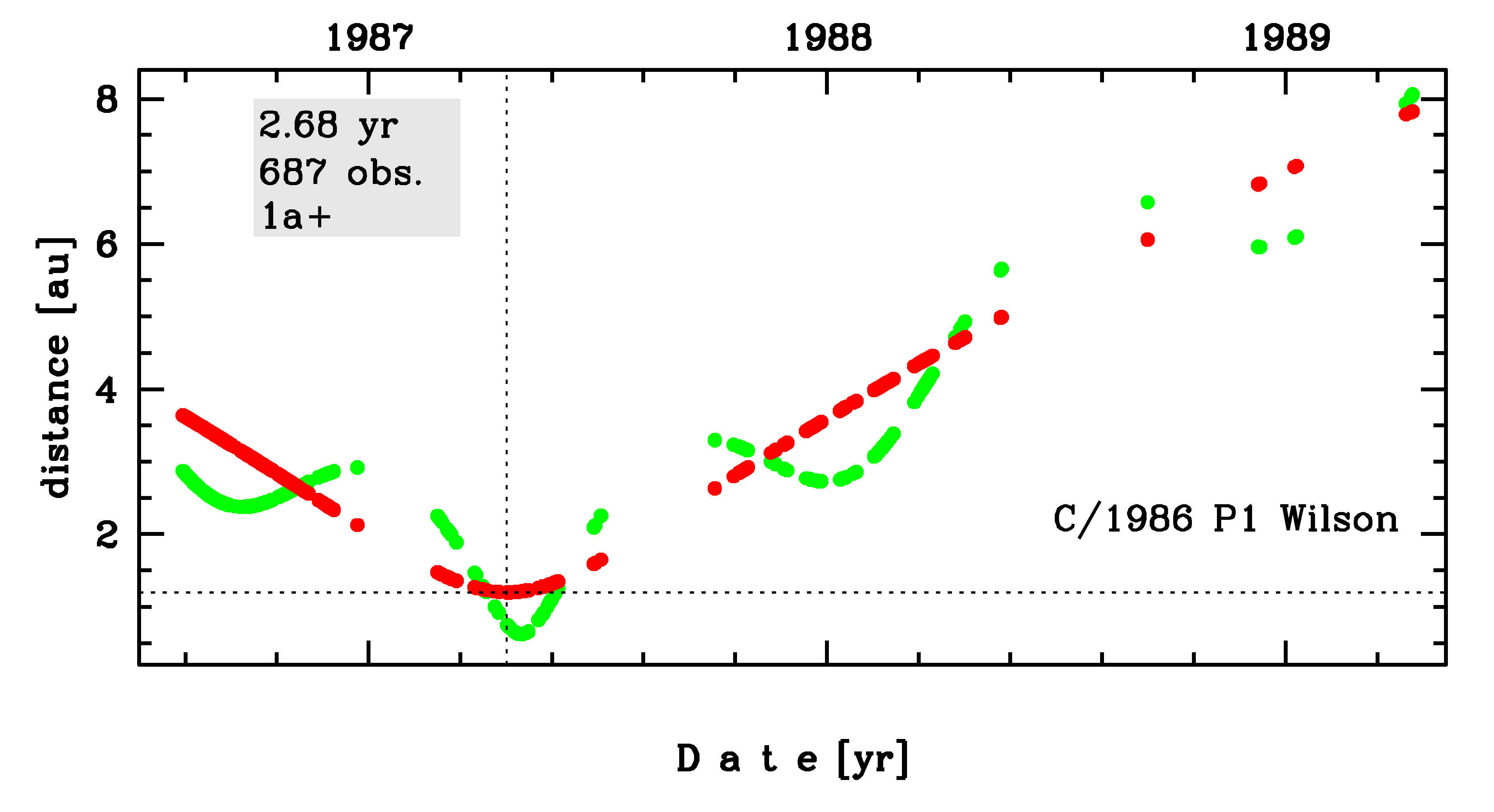C/1986 P1-A Wilson
more info
Comet C/1986 P1-A was discovered on 5 August 1986 by Christine Wilson (Mount Palomar, California, USA), that is 8.5 months before its perihelion passage.
This comet was last observed in mid-April 1989. Splitting event observed in comet Wilson was occured after perihelion passage.
Comet had its closest approach to the Earth on 1 May 1987 (0.623 au), less than two weeks after perihelion passage. According to Minor Planet Center, the main component A of this comet exhibits nongravitational acceleration in the time interval 5 August 1986 – 11 April 1989. Therefore, the non-gravitational orbit from the whole observational arc (spanning over 2.68 yr in a range of heliocentric distances: 3.64 au – 1.200 au (perihelion) – 7.83 au.) are given here as preferred orbit.
This Oort spike comet suffers large planetary perturbations during its passage through the planetary system; these perturbations lead to a more tight future orbit with semimajor axis of about 1,300 au.
See also Królikowska and Dybczyński 2010, Królikowska 2014 and Królikowska 2020.
Comet had its closest approach to the Earth on 1 May 1987 (0.623 au), less than two weeks after perihelion passage. According to Minor Planet Center, the main component A of this comet exhibits nongravitational acceleration in the time interval 5 August 1986 – 11 April 1989. Therefore, the non-gravitational orbit from the whole observational arc (spanning over 2.68 yr in a range of heliocentric distances: 3.64 au – 1.200 au (perihelion) – 7.83 au.) are given here as preferred orbit.
This Oort spike comet suffers large planetary perturbations during its passage through the planetary system; these perturbations lead to a more tight future orbit with semimajor axis of about 1,300 au.
See also Królikowska and Dybczyński 2010, Królikowska 2014 and Królikowska 2020.
| solution description | ||
|---|---|---|
| number of observations | 687 | |
| data interval | 1986 08 05 – 1989 04 11 | |
| data type | perihelion within the observation arc (FULL) | |
| data arc selection | entire data set (STD) | |
| range of heliocentric distances | 3.64 au – 1.20 au (perihelion) – 7.83 au | |
| type of model of motion | NS - non-gravitational orbits for standard g(r) | |
| data weighting | YES | |
| number of residuals | 1361 | |
| RMS [arcseconds] | 1.11 | |
| orbit quality class | 1a | |
| next orbit statistics, both Galactic and stellar perturbations were taken into account | ||
|---|---|---|
| no. of returning VCs in the swarm | 5001 | * |
| no. of escaping VCs in the swarm | 0 | |
| no. of hyperbolas among escaping VCs in the swarm | 0 | |
| next reciprocal semi-major axis [10-6 au-1] | 764.19 – 767.22 – 770.22 | |
| next perihelion distance [au] | 1.20346 – 1.20348 – 1.2035 | |
| next aphelion distance [103 au] | 2.595 – 2.606 – 2.616 | |
| time interval to next perihelion [Myr] | 0.04643 – 0.0467 – 0.04697 | |
| percentage of VCs with qnext < 10 | 100 | |
| next_g orbit statistics, here only the Galactic tide has been included | ||
|---|---|---|
| no. of returning VCs in the swarm | 5001 | * |
| no. of escaping VCs in the swarm | 0 | |
| no. of hyperbolas among escaping VCs in the swarm | 0 | |
| next reciprocal semi-major axis [10-6 au-1] | 764.19 – 767.23 – 770.23 | |
| next perihelion distance [au] | 1.20205 – 1.20205 – 1.20205 | |
| next aphelion distance [103 au] | 2.595 – 2.606 – 2.616 | |
| time interval to next perihelion [Myr] | 0.04644 – 0.04671 – 0.04698 | |
| percentage of VCs with qnext < 10 | 100 | |
